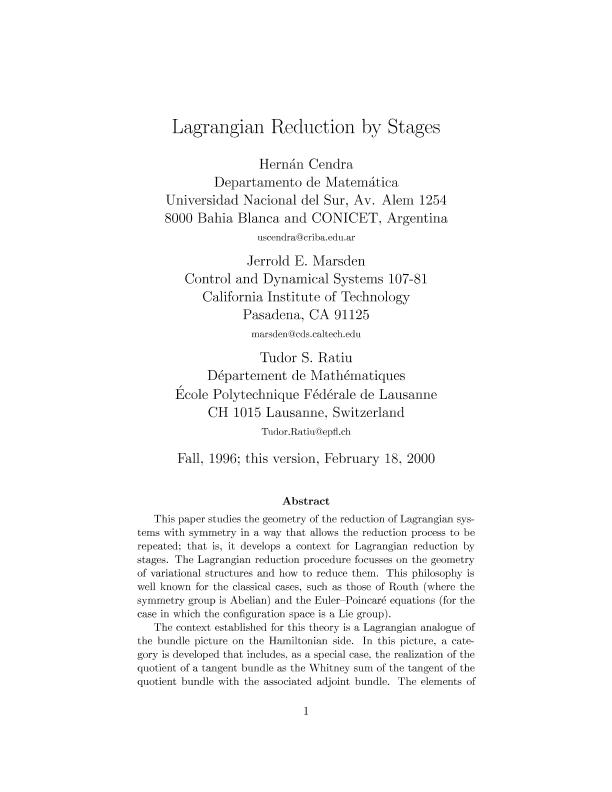Mostrar el registro sencillo del ítem
dc.contributor.author
Cendra, Hernan

dc.contributor.author
Marsden, Jerrold E.
dc.contributor.author
Ratiu, Tudor Stefan
dc.date.available
2019-06-18T20:07:36Z
dc.date.issued
2001
dc.identifier.citation
Cendra, Hernan; Marsden, Jerrold E.; Ratiu, Tudor Stefan; Lagrangian Reduction by Stages; American Mathematical Society; Memoirs Of The American Mathematical Society (ams); 152; 722; 2001; 1-108
dc.identifier.issn
0065-9266
dc.identifier.uri
http://hdl.handle.net/11336/78488
dc.description.abstract
This paper studies the geometry of the reduction of Lagrangian sys-tems with symmetry in a way that allows the reduction process to berepeated; that is, it develops a context for Lagrangian reduction bystages. The Lagrangian reduction procedure focusses on the geometryof variational structures and how to reduce them. This philosophy iswell known for the classical cases, such as those of Routh (where thesymmetry group is Abelian) and the Euler{Poincaré equations (for thecase in which the con guration space is a Lie group).The context established for this theory is a Lagrangian analogue ofthe bundle picture on the Hamiltonian side. In this picture, a cate-gory is developed that includes, as a special case, the realization of thequotient of a tangent bundle as the Whitney sum of the tangent of thequotient bundle with the associated adjoint bundle. The elements of this new category, called the Lagrange-Poincaré category, have enoughgeometric structure so that the category is stable under the procedureof Lagrangian reduction. Thus, reduction may be repeated, giving thedesired context for reduction by stages.We also give an intrinsic and geometric way of writing the reducedequations, called the Lagrange-Poincaré equations, using covariant de-rivatives and connections. In addition, the context includes the inter-pretation of cocycles as curvatures of connections and is general enoughto include interesting situations involving both semidirect products andcentral extensions. Examples are given to illustrate the general theory.
dc.format
application/pdf
dc.language.iso
eng
dc.publisher
American Mathematical Society

dc.rights
info:eu-repo/semantics/openAccess
dc.rights.uri
https://creativecommons.org/licenses/by-nc-sa/2.5/ar/
dc.subject
Poincare Equations
dc.subject.classification
Matemática Pura

dc.subject.classification
Matemáticas

dc.subject.classification
CIENCIAS NATURALES Y EXACTAS

dc.title
Lagrangian Reduction by Stages
dc.type
info:eu-repo/semantics/article
dc.type
info:ar-repo/semantics/artículo
dc.type
info:eu-repo/semantics/publishedVersion
dc.date.updated
2019-06-12T14:21:17Z
dc.identifier.eissn
1947–6221
dc.journal.volume
152
dc.journal.number
722
dc.journal.pagination
1-108
dc.journal.pais
Estados Unidos

dc.journal.ciudad
Providence
dc.description.fil
Fil: Cendra, Hernan. Universidad Nacional del Sur. Departamento de Matemática; Argentina. Consejo Nacional de Investigaciones Científicas y Técnicas. Centro Científico Tecnológico Conicet - Bahía Blanca; Argentina
dc.description.fil
Fil: Marsden, Jerrold E.. California Institute of Technology; Estados Unidos
dc.description.fil
Fil: Ratiu, Tudor Stefan. Ecole Polytechnique Federale de Lausanne; Suiza
dc.journal.title
Memoirs Of The American Mathematical Society (ams)

dc.relation.alternativeid
info:eu-repo/semantics/altIdentifier/url/http://www.ams.org/books/memo/0722/
dc.relation.alternativeid
info:eu-repo/semantics/altIdentifier/doi/http://dx.doi.org/10.1090/memo/0722
Archivos asociados
